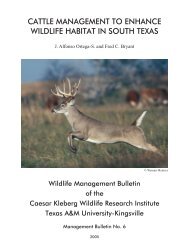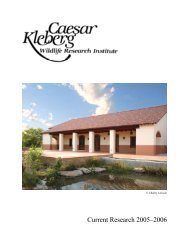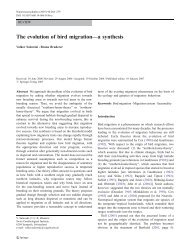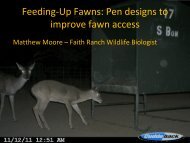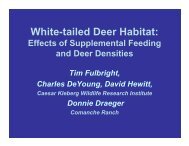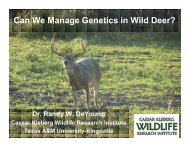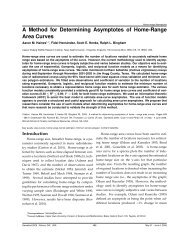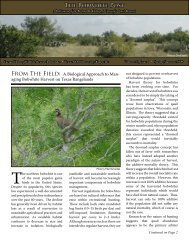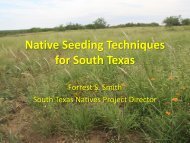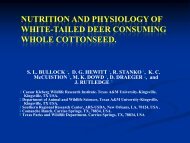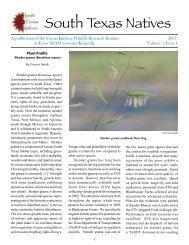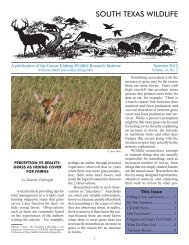The Northern Yellowstone Elk: Density Dependence and Climatic ...
The Northern Yellowstone Elk: Density Dependence and Climatic ...
The Northern Yellowstone Elk: Density Dependence and Climatic ...
You also want an ePaper? Increase the reach of your titles
YUMPU automatically turns print PDFs into web optimized ePapers that Google loves.
J. Wildl. Manage. 66(1):2002DENSITY DEPENDENCE IN YELLOWSTONE ELK * Taper <strong>and</strong> Gogan 111(AIC)Ricker, 2 a, & lb,v (0.00)Ricker, 1 a, b, & v (0.43)Ricker, 2 b, & 1 a,v (0.75)Ricker, 2 a, b, & 1 v (0.80)Gompertz, 2 a, b, & 1 v (2.00)Gompertz, 2 b, & 1 a,v (2.75)Gompertz, 1 a, b, & v (3.36)Ricker, 2 a, b, & v (3.48)Gompertz, 2 a, b, & v (4.59)Exp single model (5.74)Gompertz, 2 a, & 1b,v (6.60)Exp double model (11.16)R<strong>and</strong>om walk (18.68)Two stationary dist (41.21)Single stationary dist (59.70)-25 -20 -15 -10 -5 -0SIC valuesFig. 2. Schwarz Information Criteria (SIC) selection for appropriatemodels to describe observed trends in populationchange, northern <strong>Yellowstone</strong>lk herd, 1965-1995, Montana<strong>and</strong> Wyoming. Values of SIC for each model are given inparentheses on the Y-axis. Numbers of intercept (a), slope(b), <strong>and</strong> error (v) terms indicated.On the other h<strong>and</strong>, selection by minimum AIC isasymptotically equivalent to selection by minimumprediction error (Stone 1977). Becauseour primary intention is to identify the underlyingform of population dynamics of the northern<strong>Yellowstone</strong> elk herd <strong>and</strong> not to make explicitpredictions, use of the SIC is appropriate.Models Considered.-<strong>Density</strong>-independent modelclasses are r<strong>and</strong>om walk <strong>and</strong> exponential growthmodels. Included in the density-dependent classare Gompertz (1825) <strong>and</strong> Ricker (1954) models.We included models that differentiated populationdynamics in the early <strong>and</strong> late periods fordensity-independent <strong>and</strong> density-dependentgrowth model classes. For example, we consideredRicker <strong>and</strong> Gompertz growth models withintercept, slope, <strong>and</strong> variance parameters commonto the early <strong>and</strong> late periods, <strong>and</strong> Ricker <strong>and</strong>Gompertz models that allowed >1 of these parametersto differ between the periods. In Rickermodels, the relationship between growth rate<strong>and</strong> population density is linear, while for Gomnpertzmodels, growth rate is linearly associatedwith the logarithm of population size (Fig. 2).We also included the stationary statistical distri-bution models. This class of models does notassume any dependence of population size at agiven time on the population size at any previoustimes. Population sizes are simply assumed to bedrawn from some r<strong>and</strong>om distribution.Surprisingly, in such a situation, growth rateswill be negatively correlated with population size.This phenomenon was first pointed out by Eberhardt(1970), <strong>and</strong> has been discussed recently byWolda <strong>and</strong> Dennis (1993) <strong>and</strong> by Wolda et al.(1994). Wolda <strong>and</strong> Dennis (1993) demonstratethat rainfall can yield a significant result in a testof density dependence. This may be disturbing tobiologists. However, stationary statistical distributiondoes not necessarily indicate an absence ofdirect causal density dependence. For example, aGompertz growth model with a growth rate parameterof 1 will generate a log-normal stationarydistribution of population sizes where populationsize at a given time is independent from populationsize at any previous time. We have explicitlyincluded the stationary statistical distributionmodel class to alleviate the uncertainty generatedby this situation. If a model is identified as a density-dependentmodel but is strongly distinguishablefrom a stationary distribution, then a caveatthat could be raised against deciding the populationdynamics represents biological densitydependence has been removed.Recent work has successfully used nonparametriccurve fitting <strong>and</strong> generalized additive modelsto investigate density dependence in natural populations(Bj0rnstad et al. 1999). <strong>The</strong>se techniquesare data intensive; for example, Bj0rnstadet al. (1999) analyzed a composite dataset with250 observations. Such an approach cannot besuccessfully applied to the northern <strong>Yellowstone</strong>elk herd because of the paucity of data.Assessing the Impacts of EnvironmentalFactorsTo determine the impact of weather on thepopulation dynamics of the northern <strong>Yellowstone</strong>elk herd, we include weather variables as covariatesin some population dynamic models. Fames'(1996) weather severity index is a weighted sumof 3 normalized components: winter forage avail-ability, snow depth, <strong>and</strong> winter temperature. Allcomponents are constructed so that higher num-bers indicate milder winters. Thus, a high valuefor the snow component indicates low snow levels.We do not use Fames' full index, but insteaduse his 3 components directly. This enables themost effective weightings to emerge from thedata. Weather variables used (Table 3) comefrom Fames' most recent revision of his compilationof 30 of <strong>Yellowstone</strong> climate data (P. Fames,Soil Conservation Service, personal communica-tion). We consider these 3 variables, their l-yearlags (previous year's values), <strong>and</strong> all squares ofthese variables in looking for the effect of weatheron elk population dynamics. We also considerthe current spring's precipitation <strong>and</strong> its square.



